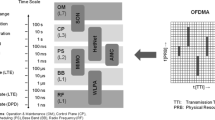Abstract
Distributed control schemes allow base stations in personal communication systems to be placed at locations corresponding to high expected traffic. This flexible base station placement creates significant overlapping coverage areas that can be utilized to improve system performance [1]. A new technique for dynamic base station selection in systems with overlapping cells is considered and its effect on traffic performance is characterized. The technique realizes robust performance for personal communication systems in fluctuating and heavily tapered traffic. A mathematical analysis based on a state transition model is used to evaluate performance of a system that employs the proposed technique. The results indicate that improved blocking probability and carried traffic performance are obtainable. Computer simulations were undertaken confirm the analytical results.
Similar content being viewed by others
References
H. Takanashi and T. Tanaka, “Dynamic Micro-Cell Assignment Technique with Distributed Control Scheme”, in Proc. IEEE PIMRC '95, October 1995, pp. 567–571.
H. Takanashi and S.S. Rappaport, “Dynamic Base Station Selection for Personal Communication Systems with Distributed Control Schemes”, CEAS Report #731, December 10, 1996, College of Engineering and Applied Sciences, State University of New York, Stony Brook, NY 11794.
H. Takanashi and S.S. Rappaport, “Dynamic Base Station Selection for Personal Communication Systems with Distributed Control Schemes”, to be published in Proc. IEEE VTC '97, May 1997.
I. Katzela and M. Naghshineh, “Channel Assignment Schemes for Cellular Mobile Telecommunication Systems: A Comprehensive Survey”, IEEE Personal Communications, Vol. 3, No. 3, pp. 10–31, 1996.
D. Everitt, “Traffic Capacity of Cellular Mobile Communications Systems”, Comp. Networks ISDN Sys., Vol. 20, pp. 447–454, 1990.
T. Fujii and S. Nishioka, “Selective Handover for Traffic Balance inMobile Radio Communications”, in Proc. IEEE ICC '92, Vol. 4, June 1992, pp. 212.3.1–212.3.7.
M. Kuwahara, Mobile Telephone, 3rd edn., Tokyo: IEICE Press, 1985.
S.S. Rappaport, “The Multiple-Call Hand-Off Problem in High-Capacity Cellular Communication Systems”, IEEE Trans. on Veh. Tech., Vol. 40, No. 3, pp. 546–557, 1991.
S.S. Rappaport, “Blocking, Hand-Off and Traffic Performance for Cellular Communication Systems with Mixed Platforms”, IEE Proceedings-1, Vol. 140, No. 5, pp. 389–401, 1993.
Author information
Authors and Affiliations
Rights and permissions
About this article
Cite this article
Takanashi, H., Rappaport, S.S. Dynamic Base Station Selection for Personal Communication Systems with Distributed Control Schemes. Wireless Personal Communications 11, 185–207 (1999). https://doi.org/10.1023/A:1018392809830
Issue Date:
DOI: https://doi.org/10.1023/A:1018392809830




